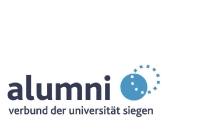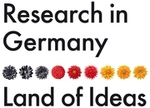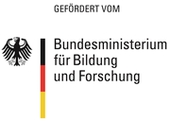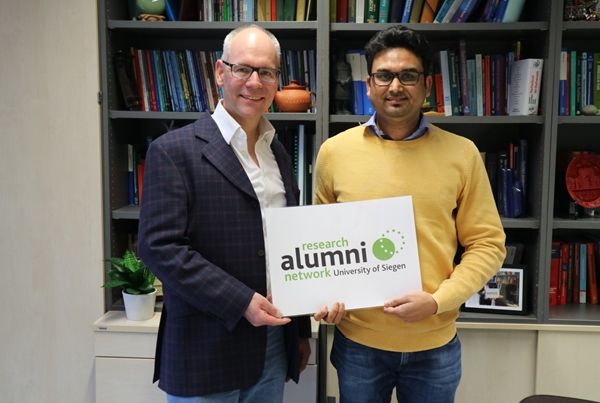- Alexander von Humbold-Stiftung prämiert Konzept zur Vernetzung der Forscher-Alumni
- Forscher-Alumni im "Querschnitt 5/2016"
- Forscher-Alumni im "Querschnitt 4/2017"
- Forscher-Alumni im "Querschnitt 1/2018"
- Forscher-Alumni im "Querschnitt 2/2018"
- Forscher-Alumni im "Querschnitt 3/2018"
- Forscher-Alumni im "Querschnitt 1/2019"
- Forscher-Alumni im "Querschnitt 2/2019"
- Forscher-Alumni im "Querschnitt 3/2019"
- Forscher-Alumni im "Querschnitt 1/2020"
- Forscher-Alumni im "Querschnitt 2/2020"
Dr. Dipankar Das - Prof. Dr. Holger Schönherr
How can a gummy bear-like substance help to detect bacteria in wounds or drinking water?
Since becoming an Alexander von Humboldt Postdoctoral scholar, Dr. Dipankar Das has been busy working on his latest research project at the University of Siegen in cooperation with Prof.Dr. Holger Schönherr and his colleagues in the research group Physical Chemistry I of the Department Chemistry – Biology at the University of Siegen.
Dr. Das’ research focuses on the fabrication of biopolymer-based chemically crosslinked elongated nanogels for biomedical applications, such as drug delivery and bio-sensing. One way to visualize, what a nanogel can do, is to imagine a gummy bear. When placed in water, a gummy bear is able to absorb large amounts of water without being dissolved itself. Nanogels work in a similar manner. However, due to its large surface to volume ratio, rapid swelling properties, and enzymatic degradation behavior, a functionalized nanogel could act as a promising biosensor for bacteria detection in wounds and drinking water.
It was while he was studying to obtain his Ph.D. degree, his Ph.D. supervisor undertook a research visit to Prof. Schönherr´s Lab. After returning to India, his Ph.D. supervisor inspired him to work in Prof. Schönherr´s Group at the University of Siegen, Germany. After the completion of his Ph.D., Dr. Das went to South Korea for his first Postdoctoral research position and started to work on his application for an Alexander von Humboldt Postdoctoral Fellowship. Eventually he was selected for the Fellowship in July 2018 and arrived in Germany at the end of 2018 for a 2 months’ language course. Subsequently, Dr. Das joined the University of Siegen in January 2019.
Another reason Dr. Das came to Siegen was to take his research to a new direction. He tried to figure out whether chemically crosslinked biopolymeric nanogels could be synthesized through a new method called extrusion. Currently, the standard methods afford spherical nanogel particles. The new alternative method promised to produce biopolymer-based elongated nanogel fibers with high aspect ratio. This is an interesting new avenue for biopolymeric nanogels, as these longer structures allow for different properties and sensitivities to manifest, thus broadening the scope of applications. So far, Dr. Das' project has had some success with using this new extraction method. His next step is to see, whether these types of nanogels could be used to detect bacteria in wounds or in drinking water.
As the Dean of Faculty IV, Prof. Schönherr now divides his time between overseeing the School of Science and Technology and his research group. Despite this, he is still is able to find time to continue to foster collaborations as his lab continues to attract many international guests to Siegen. When asked how he is able to create such a welcoming research environment for so many scientists, Prof. Schönherr acknowledges that it is difficult to say what exactly makes a place welcoming for international visitors. If someone were to create and implement a plan to accomplish this and expect fast results, they would probably be disappointed. What is necessary is focusing on the people involved in these collaborations, fostering them and building relationships with them over time. Of course there are many different personalities in the lab, some who are shy, others who are more outgoing, but ultimately they all have a shared passion for their research.
For Dr. Das, coming to Siegen has allowed him to develop expertise in a new area of his research field. In addition to this, he has also welcomed the opportunity to experience the city itself. He appreciates how German society values education over wealth. Being close to nature is highly beneficial for researchers seeking inspiration. In Siegen he has everything he needs, although he does find the hilly terrain difficult to navigate at times. Prof. Schönherr helpfully reminds him that climbing these hills is great exercise. One other thing about Siegen, which is noteworthy for Dr. Das is, of course, the weather. Every time it rains here, he is reminded of a song he used to sing to himself during his childhood: “Rain, rain, go away, come again another day.”
Dr. Das is motivated by the prospect of using his research to help those who need it most. Once his stay in Siegen is completed, he will first apply for an academic position in India. His research on the development of biopolymer-based gels could be hugely beneficial for the society, where pollution created by non-degradable polymers is a red alert for the environment.
This article is based on an interview with Dr. Dipankar Das and Prof. Dr. Holger Schönherr and was written by Benjamin Wrigley.






